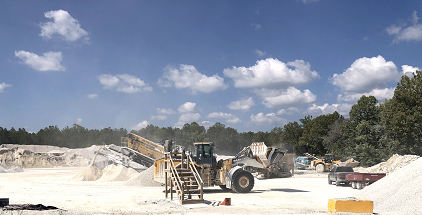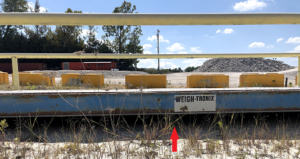Hard, Dirty and Dangerous
Quarry work is hard, dirty and dangerous. That became evident to me in the summer of 1973 when I worked at the limestone quarry in Millersburg, Missouri.
A man I knew got me the job there for the summer. My status as the new guy put me at the bottom rung of the ladder. That meant working in the crusher house. It was quite the experience.
On a recent trip to Kansas City I decided to go back and take a look at the quarry. It had changed a lot in the almost 50 years that had elapsed. First of all, the site I had worked at was shut down. The quarry was now on a plot of land about 250 yards to the south. And all the equipment had changed. What you see in the picture at the top of this post is not what I was working with.
The Crusher House
In 1973 we had what was called a crusher house. The floor of this building was about thirty feet off the ground. It was a building with a 2×4 frame and corrugated steel walls.
It housed the jaws of a huge industrial rock crusher. This consisted of two large, vertical metal plates that moved repeatedly in a pinching motion to crush the rocks dumped by a gigantic dump truck. This is not your common on-road dump truck. This is one that is designed specifically for large loads in quarries and mines.
These trucks would be filled with large rocks that had been blown off the quarry wall by dynamite. The fully loaded truck would back up to a slope located above the crusher house. Then it would dump tons of limestone down this slope.
The rock would crash down the hill into a chute in the crusher house wall onto an assembly of, vibrating parallel steel bars. These bars were about four inches apart. Anything small than four inches would fall through and be carried off by one of a series of conveyor belts. Anything still on the steel bars would vibrate down toward the jaws of the crusher.
My job consisted primarily of leaning across these vibrating steel bars and picking out any pieces of rock that looked like chert. Chert is a hard, fine-grained rock made up mostly of the mineral silica (SiO2). Known also as flint it is one of the most abundant rocks in Missouri. The chert would be mixed in with the limestone from the blast. The finished product we were producing could only have 2% chert in it because we were crushing for a state highway project. They had certain requirements that had to be met.
This is how I was first introduced to what is known as carpal tunnel syndrome. I would sit by these vibrating steel bars wearing leather gloves and reach into the rocks and pull out the chert by hand. The pieces ranged from about the size of a baseball to the size of a bowling ball.
A pair of leather gloves would last about a week before the fingers wore through from the sharp edges of the rock.
Carpal Tunnel Syndrome
I had been working at the quarry about three days when I woke up one night and the fingers on both of my hands were contracted like claws. My forearms were in excruciating pain. I had no idea what was going on. At the time all I wanted was for the pain to stop. I got up and managed to massage my forearms with my knees until my fingers slowly loosened up. I passed it off at the time to just a strange, random event.
By morning my forearms still ached. It wasn’t until I picked up my first piece of chert that day that I made the connection.
That is a fair description of what I did most days. When the truck arrived at the top of the hill a light would come on in the crusher house. I, and my co-worker across from me, would step back from the chute, put our backs against the wall and wait for tons of rock to crash into our work area.
One day one of the larger rocks went astray, bounced when it hit the bottom of the chute, and crashed right through the other side of the crusher house. You can imagine the noise that made. There were other times when pieces of rock came into the house that were too large to fit into the jaws of the crusher. That was how I learned how to use a sledgehammer to make little rocks from big rocks.
Making Big Rocks Into Little Rocks
My first inclination was to take the hammer and slam it into the middle of the big rock. That produced little results no matter how many times I did it. Then my co-worker showed me how to do it. Take off small pieces at a time. Hit around the edge of the rock and the pieces will fall off a lot easier. It worked. Lesson learned.
Learning how to wield a sledgehammer put me in one of the most frightening situations of my employment at the quarry. In addition to the quarry the company owned and operated a ready-mix concrete plant just a few miles away in Fulton, Missouri.
A ready-mix concrete plant is where empty concrete trucks arrive, pull under some overhead silos and get the materials dumped into the revolving drum that makes concrete. You have probably noticed concrete trucks with the big drums rotating as they drive by. Those trucks have been to the ready-mix plant and the drum is mixing the ingredients for concrete.
One of the most important components of concrete is cement. It is a fine, powdery mix of substances. It must be kept dry, or it will form into a rock.
You Can’t Be Serious
It just so happened that moisture had somehow gotten into the cement silo in Fulton. This caused the silo to clog up and it quit dispensing the cement. The solution was to send a man out onto a 2×12 board that was located about twenty feet in the air. This was the only way to reach the silos. This man was then to take a sledgehammer and beat on the side of the steel silo that contained the cement until the clog was eliminated. I was to be that man.
It was an easy call for the boss. He knew I spent the better part of the day swinging that hammer and I was the new-hire, low man on the totem pole and nobody else wanted to do that job.
I didn’t know what they were sending me to do until I got there. I had never been to a ready-mix plant and knew nothing about the setup.
I should stop here and tell you that I have a fear of edges. This is not a fear of heights. Flying doesn’t bother me. Jumping out of perfectly good airplanes doesn’t bother me. Standing at observation points on tall buildings doesn’t bother me. But being near an edge, without some type of railing to keep me from being sucked over the precipice gives me the smothers.
I could easily stand in the middle of an eight-foot round table as it sat on the floor. If you raised that table to about ten feet off the floor, I would start to get extremely anxious.
The plant manager took me over to the silo and explained the problem. He then pointed to a steel ladder that went up to the base of the silo. “Climb up there, go out on that board and just keep hitting the bottom of the silo until the clog breaks up.”
My heart sank. I couldn’t say “no.” I wasn’t about to tell this stranger about my fear of edges. I wasn’t sure that he would understand, but I was sure he wouldn’t care.
The first problem I faced was how to climb a vertical steel-rung ladder carrying a 16-pound sledgehammer. I decided to loosen my belt and tuck the handle in so it ran along my leg. That worked.
When I got to the top all I could see was the 2×12 board that stretched out from the top of the ladder under the silos. I mean that was it. No rails. Nothing to hold onto until I got to the silo.
The distance from the ladder to the silo was only about fifteen feet but it seemed like a mile. I pulled the hammer from my belt and headed out. It seemed like it took an hour to go those fifteen feet, but I eventually made it to the silo. When I arrived, I found myself at the bottom of the silo. The place I was told to hit with the hammer was about two feet over my head.
When I got into position, I could steady myself by putting my one hand against the silo. I had the hammer in my other hand. Now I had to figure out how I was going to swing this hammer over my head and not fall off this board.
I positioned my feet. Then I grabbed the hammer with both hands and took my first swing up over my head.
I Forgot About Gravity
It had not occurred to me that when the steel head of the hammer banged against the steel side of that silo it was going to bounce back faster than it went up. There is a thing called gravity in play here. It was 16 pounds of steel going up and felt like 50 pounds of steel coming back. I almost lost my balance and tumbled down to the concrete below.
This was not good.
I took a few more swings and decided that was not going to work. To say I was profusely sweating would be an understatement. I looked around and found a small metal fixture protruding from the side of the silo. It was just big enough to hold onto with my fingers. I did. From that moment on I became a one-armed sledgehammer wielder. I held onto the metal fixture as hard as I could with the fingers of my left hand and swung the hammer up over my head with my right arm.
It took a while but suddenly the clog broke up and the cement started to flow again. All I had to do was make it back to the ladder. I took a deep breath, kept my eyes fixed on the ladder and holding the hammer like a balancing bar made it to safety.
The summer wore on. Pick chert or breaks rocks in the morning. Stop for lunch. Pick chert or breaks rocks in the afternoon. The hours passed slowly.
Busting Rocks and Singing My Songs
The noise in the crusher house was too loud to engage in conversation with the man on the other side of the chute. At that time in my life, I played guitar. To keep my sanity during the day I would sing my repertoire from beginning to end as many times as necessary.
One day the boss came and called me out of the crusher house. I was really hoping he was not going to send me back to Fulton. Instead, he had another job for me.
Quarries sell rocks. I know you knew that. Do you know how they know how much to charge?
A Weighty Situation
When a truck comes in it goes over a scale and gets weighed empty. After it is loaded up it leaves by going across that same scale. The empty weight of the truck is subtracted from the weight when it is full. That is how the quarry knows how many tons of rock is in the truck.
This was a limestone quarry. In addition to crushed rock of all sizes it produces limestone dust; lots of limestone dust. There is lime dust everywhere. My clothes and face would be totally white by the end of the day. The lime dust also shakes off the trucks as they pull onto the scale with a full load.
After a while that lime dust builds up under the scale and can keep it from lowering all the way. That gives an erroneous reading. The clearance between the bottom of the scale and the ground is about twenty-four inches.
What was once dust becomes hardened by time and weather. Moisture causes the lime dust to compact.
So every once in a while, somebody has to lie on his back and slide under the scale with a pickaxe and dig out the accumulated lime dust. That somebody was me that day. I had to lie on my back and slide under the scale. I also had to drag the pickaxe along with me.
The pickaxe would have to lie flat on the ground so I could use both arms to swing it back and forth over my head to loosen up the lime. Then I would let go of the pickaxe and use my hands and arms to push the dust toward my feet where the opening of the scale was. It was kind of like the motion you would use to make snow angels. Once one small area was cleared I would slide over and start working on another.
This scale was about thirty feet long. It took half a day to clean that out. The worst times in that day were when the trucks crossed the scale. I was assured before I went under there that the scale would not come down far enough to crush me. Still, I got just a little tense each time I heard a truck approach. Of course each trip produced a new deposit of lime dust.
That was just another one of those jobs that goes to the new guy.
Time To Knuckle Down
The next day we were all having lunch in the shed. As I looked around I noticed that each of the other men were missing part or all of at least one finger. I had to ask what happened. One of them spoke up.
“Oh, we lost them doing the job you are doing in the crusher house.”
I lasted the entire summer without an injury. The experience sure made me happy I went to law school.
If you would like me to be the after dinner speaker at your event and share more stories, contact me.


